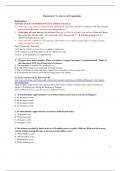Pangaea was Study guides, Class notes & Summaries
Looking for the best study guides, study notes and summaries about Pangaea was? On this page you'll find 124 study documents about Pangaea was.
All 124 results
Sort by
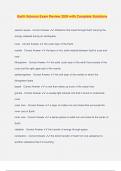 Popular
Popular
-
Earth Science Exam Review 2024 with Complete Solutions
- Exam (elaborations) • 10 pages • 2024
- Available in package deal
-
- $12.49
- 1x sold
- + learn more
Earth Science Exam Review 2024 with Complete Solutions seismic waves - Correct Answer ️️ -Vibrations that travel through Earth carrying the energy released during an earthquake. crust - Correct Answer ️️ -the outer layer of the Earth mantle - Correct Answer ️️ -the layer of hot, solid material between Earth's crust and core lithosphere - Correct Answer ️️ -the solid, outer layer of the earth that consists of the crust and the rigid upper part of the mantle asthenosphere -...
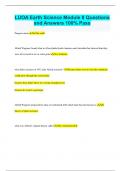
-
LUOA Earth Science Module 8 Questions and Answers 100% Pass
- Exam (elaborations) • 16 pages • 2023
- Available in package deal
-
- $9.99
- + learn more
LUOA Earth Science Module 8 Questions and Answers 100% Pass Pangaea mean all the earth Alfred Wagoner found what in Africa,India,South America and Australia that showed him they were all covered in ice at some point ice striations why didn't scientist in 1912 take Alfred seriously? because there was no way the continents could plow through the ocean basin because they didn't know of a strong enough power because he wasn't a geologist Alfred Wegener proposed his idea of continental drift wh...
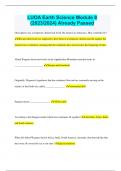
-
LUOA Earth Science Module 8 (2023/2024) Already Passed
- Exam (elaborations) • 29 pages • 2023
- Available in package deal
-
- $9.99
- + learn more
LUOA Earth Science Module 8 (2023/2024) Already Passed Glossopteris was a temperate climate leaf fossil. He found it in Antarctica. How could this be? Because that fossil was supposed to have been in a temperate climate near the equator but instead was in Antartica, meaning that the continents have moved since the beginning of time. Alfred Wegener discovered rocks in the Appalachian Mountains matched rocks in _______________________. Europe and Greenland Originally, Wegener's hypothesis that...
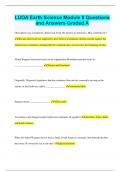
-
LUOA Earth Science Module 8 Questions and Answers Graded A
- Exam (elaborations) • 29 pages • 2023
-
Available in package deal
-
- $9.99
- + learn more
LUOA Earth Science Module 8 Questions and Answers Graded A Glossopteris was a temperate climate leaf fossil. He found it in Antarctica. How could this be? Because that fossil was supposed to have been in a temperate climate near the equator but instead was in Antartica, meaning that the continents have moved since the beginning of time. Alfred Wegener discovered rocks in the Appalachian Mountains matched rocks in _______________________. Europe and Greenland Originally, Wegener's hypothesis ...
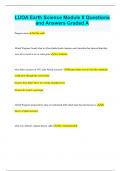
-
LUOA Earth Science Module 8 Questions and Answers Graded A
- Exam (elaborations) • 16 pages • 2023
-
Available in package deal
-
- $9.99
- + learn more
LUOA Earth Science Module 8 Questions and Answers Graded A Pangaea mean all the earth Alfred Wagoner found what in Africa,India,South America and Australia that showed him they were all covered in ice at some point ice striations why didn't scientist in 1912 take Alfred seriously? because there was no way the continents could plow through the ocean basin because they didn't know of a strong enough power because he wasn't a geologist Alfred Wegener proposed his idea of continental drift whi...
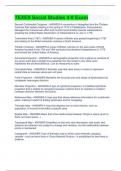
-
TEXES Social Studies 4-8 Exam
- Exam (elaborations) • 58 pages • 2023
-
- $15.99
- 1x sold
- + learn more
Second Continental Congress - ANSWER-A convention of delegates from the Thirteen Colonies that started meeting in the spring of 1775 in Philadelphia, Pennsylvania. Managed the Colonial war effort and moved incrementally towards independence, adopting the United States Declaration of Independence on July 4, 1776. Townshend Acts (1767) - ANSWER-A series of British acts passed beginning in 1767 and relating to the British American colonies in North America. Thirteen Colonies - ANSWER-A group ...
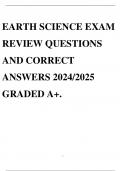
-
EARTH SCIENCE EXAM REVIEW QUESTIONS AND CORRECT ANSWERS 2024/2025 GRADED A+.
- Exam (elaborations) • 10 pages • 2024
-
- $11.99
- + learn more
EARTH SCIENCE EXAM REVIEW QUESTIONS AND CORRECT ANSWERS 2024/2025 GRADED A+. 2 / 5 1. seismic waves: Vibrationsthat travel through Earth carrying the energy releasedduring an earthquake. 2. crust: the outer layer of the Earth 3. mantle: the layer of hot, solid material between Earth's crust and core 4. lithosphere: the solid, outer layer of the earth that consists of the crust and therigid upper part of the mantle 5. asthenosphere: the soft layer of the mantle on which the lithospher...
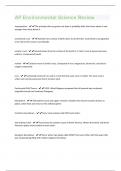
-
AP Environmental Science Review Exam |271 Questions And Answers Solved 100% Correct!!
- Exam (elaborations) • 34 pages • 2023
- Available in package deal
-
- $13.49
- + learn more
superposition - The principle that any given rock layer is probably older than those above it and younger than those below it continental crust - Extends from surface of Earth down to 20-30 miles. Continental crust (granite) is less dense then ocean crust (basalt). oceanic crust - Extends down from the surface of the Earth to 7 miles. Crust is layered and very uniform. Composed of basalt. mantle - Contains most of Earth's mass. Composed of iron, magnesium, aluminum, and siliconoxygen comp...
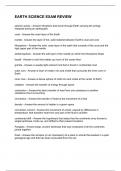
-
EARTH SCIENCE EXAM REVIEW
- Other • 7 pages • 2024
-
- $11.49
- + learn more
seismic waves - Answer-Vibrations that travel through Earth carrying the energy released during an earthquake. crust - Answer-the outer layer of the Earth mantle - Answer-the layer of hot, solid material between Earth's crust and core lithosphere - Answer-the solid, outer layer of the earth that consists of the crust and the rigid upper part of the mantle asthenosphere - Answer-the soft layer of the mantle on which the lithosphere floats basalt - Answer-a rock that makes up much ...

How did he do that? By selling his study resources on Stuvia. Try it yourself! Discover all about earning on Stuvia



